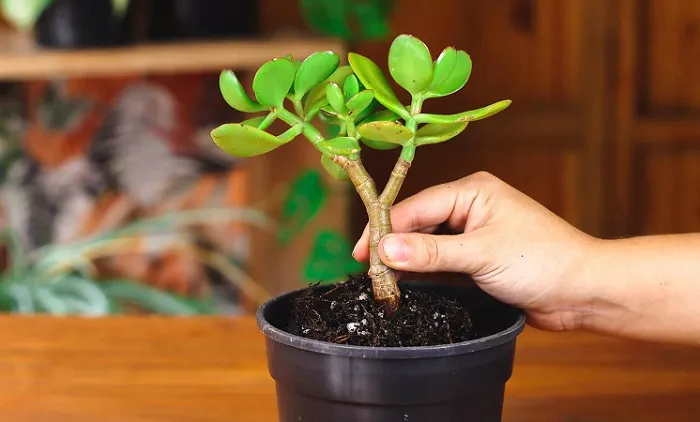Jade plants (Crassula ovata) are beloved succulents known for their thick, glossy leaves and easy-care nature. Repotting helps them grow stronger and prevents root-bound issues. Whether you’re a beginner or an experienced gardener, this guide will walk you through the process with clear, practical steps. Let’s give your jade plant the fresh start it deserves!
Why Repot a Jade Plant?
Jade plants grow slowly but can outgrow their pots over time. Repotting offers several benefits:
Fresh Soil – Nutrients deplete over time; new soil keeps your plant healthy.
Better Drainage – Prevents root rot by improving airflow and water flow.
More Space – Gives roots room to spread, promoting growth.
Pest Prevention – Removes old soil that may harbor pests or fungi.
Signs your jade needs repotting:
- Roots growing out of drainage holes.
- Soil drying too quickly.
- Stunted growth or yellowing leaves.
When to Repot a Jade Plant
The best time to repot is in spring or early summer when the plant is actively growing. Avoid winter repotting—jade plants enter dormancy and recover slowly.
Repot young jades every 2-3 years and mature ones every 4-5 years. If the plant looks stressed, wait until it’s healthier before transplanting.
Choosing the Right Pot
Material
Terracotta – Best for breathability, prevents overwatering.
Ceramic (Glazed) – Retains moisture longer, good for dry climates.
Plastic – Lightweight but traps moisture; use only if you water sparingly.
Size
Pick a pot 1-2 inches wider than the current one. Too large a pot holds excess moisture, risking root rot.
Drainage
Always choose a pot with drainage holes. Jade plants hate soggy roots!
Selecting the Best Soil
Jade plants need well-draining soil. A good mix includes:
- 50% succulent/cactus soil (for drainage).
- 25% perlite or pumice (improves aeration).
- 25% coarse sand (prevents compaction).
Avoid regular potting soil—it retains too much water.
How To Repot Jade Succulent?
Step 1: Prepare Your Tools
- New pot
- Fresh soil mix
- Small trowel or spoon
- Pruning shears (sterilized)
- Gloves (optional)
Step 2: Remove the Jade Plant
- Water lightly a day before repotting to loosen roots.
- Tilt the pot and gently tap the sides to free the plant.
- If stuck, use a knife to loosen edges.
Step 3: Inspect and Trim Roots
- Shake off old soil.
- Trim any black, mushy, or tangled roots with clean shears.
- Let the roots dry for 1-2 hours before repotting to prevent rot.
Step 4: Add Soil to the New Pot
- Place a small mesh or pebbles over drainage holes.
- Fill the bottom with fresh soil (about 1/3 of the pot).
Step 5: Position the Plant
- Set the jade in the center.
- Fill gaps with soil, pressing lightly to stabilize.
- Leave about ½ inch space below the rim for watering.
Step 6: Water Lightly & Settle
- Wait 3-5 days before watering to let roots heal.
- Place in bright, indirect light for a week before moving to direct sun.
Aftercare Tips
Watering – Wait until the top inch of soil is dry. Overwatering kills jade plants!
Light – Provide 4-6 hours of sunlight daily (east/west-facing windows are ideal).
Fertilizer – Feed once in spring and summer with diluted succulent fertilizer.
Troubleshooting Common Issues
Dropping Leaves – Usually due to overwatering or shock. Reduce water and give time to adjust.
Yellow Leaves – Check drainage; may indicate root rot.
Slow Growth – Ensure enough light and proper soil nutrients.
Repotting a jade plant is simple when done right. With fresh soil, proper drainage, and careful handling, your succulent will thrive for years. Enjoy watching your jade grow into a lush, vibrant beauty!
3 Interesting Title Ideas:
“Jade Plant Repotting Made Easy: A Foolproof Guide for Lush Growth”
“Give Your Jade a Fresh Start: The Ultimate Repotting Handbook”
“From Root Bound to Thriving: How to Repot Your Jade Succulent Like a Pro”
4 FAQs About Repotting Jade Plants
Q1: Can I repot a jade plant in winter?
A: Avoid it—jade plants are dormant in winter and recover poorly. Wait until spring.
Q2: Should I water my jade right after repotting?
A: No, wait 3-5 days to prevent root rot. Let any trimmed roots heal first.
Q3: How do I know if my jade is root-bound?
A: If roots circle the pot or grow out of drainage holes, it’s time to repot.
Q4: Can I use regular potting soil for jade plants?
A: No, it retains too much moisture. Always use a well-draining succulent mix.
Conclusion
Repotting your jade plant may seem like a small task, but it makes a big difference in its long-term health. Fresh soil, proper drainage, and a well-sized pot give your succulent the foundation it needs to grow strong and lush. By following these simple steps—choosing the right time, pot, and soil, then handling the roots with care—you’ll help your jade thrive for years to come.


